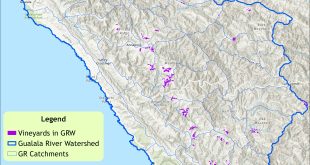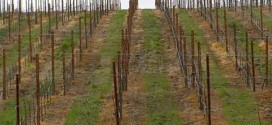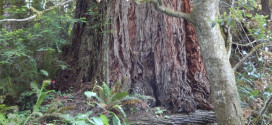| A version of this article was published in the Independent Coast Observer on July 4, 2003. |
Speakers and the committee were seeking a balance between private property rights and public property rights, and a balance between the rights of old-timers and newcomers. Properties in the northwest part of Sonoma County are sought for vineyards which require conversion from existing land uses.
After hearing speakers the CAC took a 7 – 4 straw vote to consider recommending the most protective option, which would prohibit conversions in timberland and resource zonings, at a later meeting where they would review possible changes, including “no net loss of timberland.”
The CAC began by tying up loose ends from previous meetings. They re-voted on the water element with appropriate language recommending it to the planning commission. The previous language introduced by CAC Member Steve Butler, an attorney, left the water element in limbo, said planner Scott Briggs, adding that more public input would be attached. The vote was 10-2.
The riparian (streambank) element recommendation was on the consent agenda. CAC Member Vicki Mulas moved not to approve it, but to open it for more discussion. She said landowners deprived of their property rights to grow, say, strawberries or hay, should be compensated.
Member Gayle Goldstone, who served on the riparian subcommittee, said they felt the current protections were “woefully inadequate.” They recommend increased streambank protections, which would apply to new land uses; not to existing uses. Individual landowners could negotiate exceptions if restrictions were inappropriate for the specific property.
Environmental consultant Jim Martin presented information at the June 5 CAC meeting. Goldstone said he showed that some areas are unique, “and once they’re gone, they’re gone.” The CAC voted 9 – 3 to recommend the riparian element to the planning commission.
Moving on to timberland conversions, staffer David Schiltgen explained the memo he wrote a year ago outlining four options:
- One – no change from the 1989 language;
- Two – prohibit timberland conversion of land zoned for timber production, protecting about 30 percent of the county’s timberland;
- Three – adding resource-zoned land (including most land in the northwest county), protecting about 80 percent of the county’s timberland.
- Four – a case-by-case use-permit process.
County staff recommended option two.
If the new language becomes part of the general plan, county staff could make recommendations to the California Department of Forestry, “but the extent to which CDF would follow county recommendations is still uncertain,” said Schiltgen.
Both the recommended water and riparian elements would indirectly affect proposed conversions by giving the county more grounds to assess them, he went on.
The riparian element would increase protected stream mileage from 700 to 3,700, and put more importance on preserving remaining lands.
The water element would include such general protections as increasing stream monitoring and decreasing sediment.
CAC Member Tamara Boultbee read from a letter by Rick Coates of Cazadero. Deputy County Counsel Linda Parker said she disagrees with the letter’s take on riparian setbacks, which are still being tested in the courts. “No-one can determine what the law will eventually be on this issue,” said Parker.
Later, when Coates spoke, he said he wants the legal angles re-visited. Restricting land that can be converted will not reduce timber harvest; it will still be producing timber, he said. If the timber base is reduced by conversions, the result is more and more abusive land-use practices as interests compete for the remaining timber.
He owns timberland with six creeks flowing through, said Coates, and he supports riparian protections and option three. He is worried about upstream land use damaging his property. He would like to see compensation for loss of use, for loss of public rights, and for loss of water rights caused by conversions.
Speakers for Sierra Club, California Native Plant Society and Coastal Hills Community Land Trust supported option three, as did about 15 people who raised their hands at the request of Veronica Jacobi. “Please put common sense above dollars and sense,” she said. “When something is protected, it’s not like it goes away and is lost forever.”
Petaluma rancher Al Gerhardt said that the amount of new timberland exceeds the small amount lost to conversions. He supports option one that would keep the 1989 language. He has 30 to 40 acres of timber; it is too costly to prepare a Timber Harvest Plan for it, “so I end up with a fire hazard,” and a risk of increased stream sediment from fire runoff.
Economist Don Kemp of Sea Ranch said he represents more the public property rights than the private, because those are the ones “we run the risk of crushing.” Much of the value of forests is not yet computed, and there are ecological services that come out of those forests. They’re public assets that run the risk of being damaged.
He supports option three as the most protective of public rights. Once land is planted and sprayed, the forest is not coming back, he said. Kemp said changes at the planning commission level could allow individual cases to be considered, and add a mechanism to help private landowners, including outright compensation if needed.
Ursula Jones of Friends of the Gualala River asked the CAC to take a field trip to the Annapolis area to see vineyards taking over.
Chris Poehlmann of Annapolis spoke for Coastal Forest Alliance, a citizens group responding to conversions. Some are already approved, some are in process, more are in preparation, all in the last contiguous, sparsely populated area of the county.
One conversion is from the third largest winery in the world, based in Spain, and will remove 105 acres of redwood. A few parcels away a lawyer from Las Vegas wants to put in his “vanity vineyard” on 62 acres. Poehlmann supported option three, saying that county planning goals have been in place for many years and should be upheld.
Toben Dilworth of Sebastopol spoke for Town Hall Coalition. “The public overwhelmingly supports option three,” he said, including some grape growers whose perception is that the integrity of crops is linked with the health of the ecosystem.
Tammy Nobles of Cazadero spoke for Sonoma Coast and Cazadero Communities Alliance. She said the group was started by people who recently found out that the general plan revision was going on. They collected about 300 signatures supporting less land use regulation and reduction in minimum parcel sizes so families could subdivide their land. She also invited the CAC members to visit the land and vineyards, and hear both sides.
John Rosson of Timber Cove said his family has owned timberland there since the 1920s. Using a 25-foot riparian protection zone, he figured that just on his place the cost of timber taken out of production, at the price of a 1994 harvest, would be $1.24 million.
His family logs on a 30-year rotation. For two or three weeks in 30 years they “fuss with the timber.” After a harvest the animals come in for food. “They love it.” The best timber is in riparian zones, where it provides a shade footprint for young trees to grow. By proposing riparian protections, “you’re taking the heart – literally the heart – of the timber growing land in Sonoma County,” said Rosson.
Ernie Carpenter of Occidental, a former county supervisor, recalled that when he was on the Board of Supervisors they passed county forestry rules that were turned down by the Board of Forestry, a mistake, he feels. CDF almost always follows county staff recommendations when they comment, but they hardly ever have time to comment.
Carpenter, who is one of the consultants for interests proposing 5,000 to 10,000 acres of vineyards in northwest Sonoma and southwest Mendocino counties, said that options two and three remove ag protections. “This is aimed at vineyards,” he said, by proposing hard and fast prohibitions before a problem exists.
If the county were to “lock up” resource zoning and take away ag protection, “you are saying residential development is the preferred land use.” Carpenter said options two and three have no protection for oak forest or madrones, a concern raised by several speakers, some of whom were concerned about the impact of Sudden Oak Death.
Kelly Brown cited a letter to the CAC from Supervisor Mike Reilly refuting Carpenter’s proposals. She said Director of Forestry Andrea Tuttle tells Reilly that without local land use protections, CDF has a hard time regulating conversions.
René DeMonchy of Guerneville spoke for option three. “Water is the issue that shines through,” he said, adding that throughout the county water tables are dropping in direct proportion to the amount of vineyards created. The issue is the public good versus the benefit of a few owners. If it is a property right to cut down a forest and plant vineyards – or broccoli – DeMonchy said he’s against it, because forests maintain ground water.
He said he loves wine himself, and he believes that most people who don’t like vineyard conversions are not against timber harvesting. “But if it destroys watersheds, it is a problem,” said DeMonchy. Our prosperous times now are based on water, he went on, and it is not in our best interests to convert a lush damp forest to what Chris Poehlmann calls a biological desert.
A vineyard owner said he did the math and it will take hundreds of years to convert the forest at the current rate. He said development, not vineyards, causes wells to go dry. His vineyard has bugs, animals, and all kinds of diversity. He asked for the data on the biological desert idea. He was one of several speakers on both sides of the debate who cited land use in Europe.
A Pocket Canyon resident told of the burden placed on her family and neighbors by a proposed vineyard conversion that threatens osprey, spotted owl, and their community well that serves 50 people. CDF has made three Pre-Harvest Inspections and produced a huge report that cost 400 or more staff hours from agencies. “The person who plans the conversion is not paying for this staff work, so we re all paying for his profit,” she said, adding that steps to protection will save the public money.
Carl Danskin said that almost all conversion in Annapolis was in the last three years, and much more is in the works. Whether all land is taken further east, or realtors are taking it as a bonanza, the pace of conversion is accelerating. He said option two would not cover where he lives, and advocated option three.
Robert Schneider, a third generation timberland owner in Cazadero, proposed that for every acre converted, an acre on the same property be converted to timber. This idea proved popular with committee members in their discussion which followed.
CAC Chair Don Marquardt asked committee members if they had ideas for additions, such as protections for oaks and madrones, or compensation for landowners. Several supported each.
Boultbee was concerned about cumulative impacts, and possible abuse of language allowing conversions for “overriding public benefit.” Planner Bob Gaiser said that the Sea Ranch Reservoir is a good example of a timberland conversion for public benefit. He also said that a proposal that option three apply in the northwest county and option two in the rest of the county could cause legal problems.
Dan Fein said there is tremendous pressure to convert, with more in the works. “I have the feeling if you looked at it, it would be geometric.” He moved to recommend option three and got a second.
Donna Mazzucchi said she would like to go through option three, looking for ways to mitigate property rights concerns. Marquardt asked, “Is that something everyone wants to do?” Bob Marshall of Sea Ranch said water, riparian and timber are all still on their minds, and some kind of economic equity can be applied to all three issues.
Mulas asked staff to give reasons for their recommendation of option two. Schiltgen said they looked at goals and values in county history. TPZ landowners do get preferential treatment and protection from interference by non-compatible land uses.
“Certainly, if you’re removing the whole forest, you can’t interfere any more than that.” The only thing we’re prohibiting is conversion, he said, not timber growing and cutting.
Gaiser added that resource zoning covers many uses. Timberland is a term of art, not any land with a tree on it; there is a lot of land zoned TPZ without much timber on it, and nothing in the recommendations would prevent ag use on the rest of it.
Fein amended his motion to have staff bring back possibilities allowing for some mitigations such as “no net loss of timberland.” Schiltgen agreed. The straw vote was 7 yes, 4 no.
The CAC continued the timber conversion discussion on July 17, and again sent the language back to staff for more work.
 Friends of Gualala River Protecting the Gualala River watershed and the species living within it
Friends of Gualala River Protecting the Gualala River watershed and the species living within it


